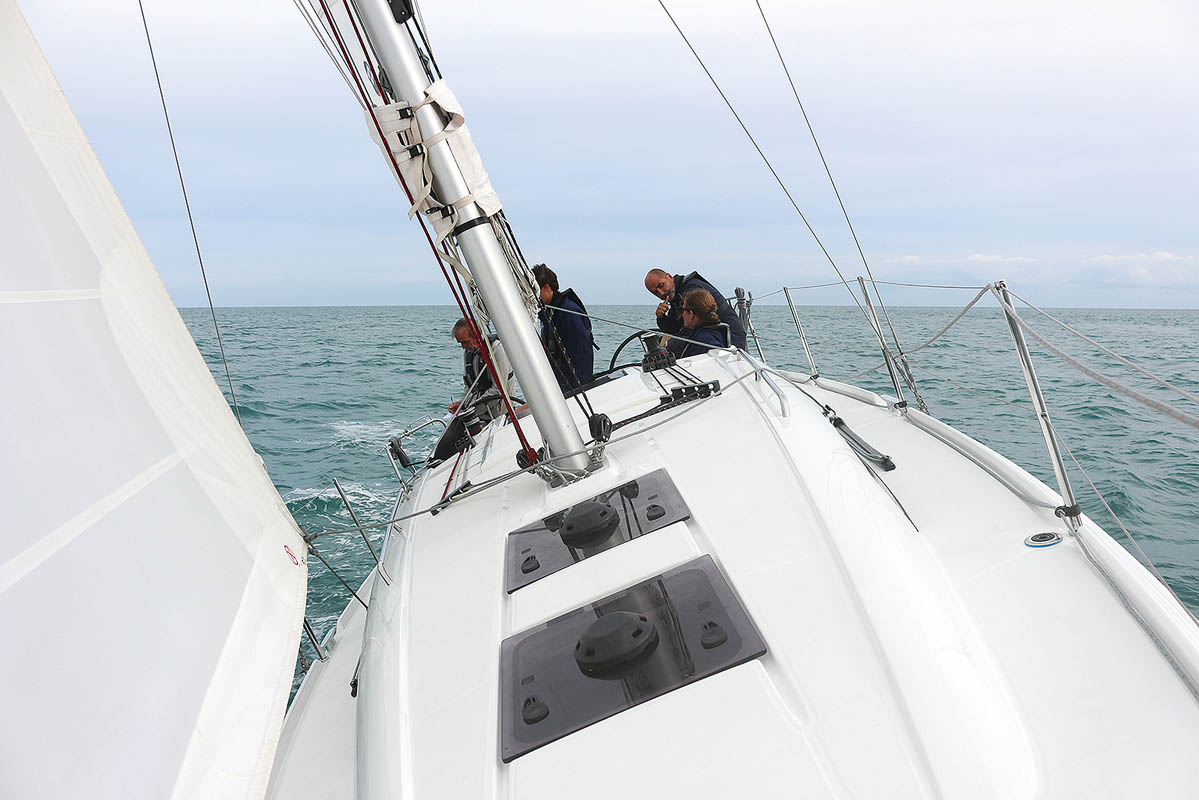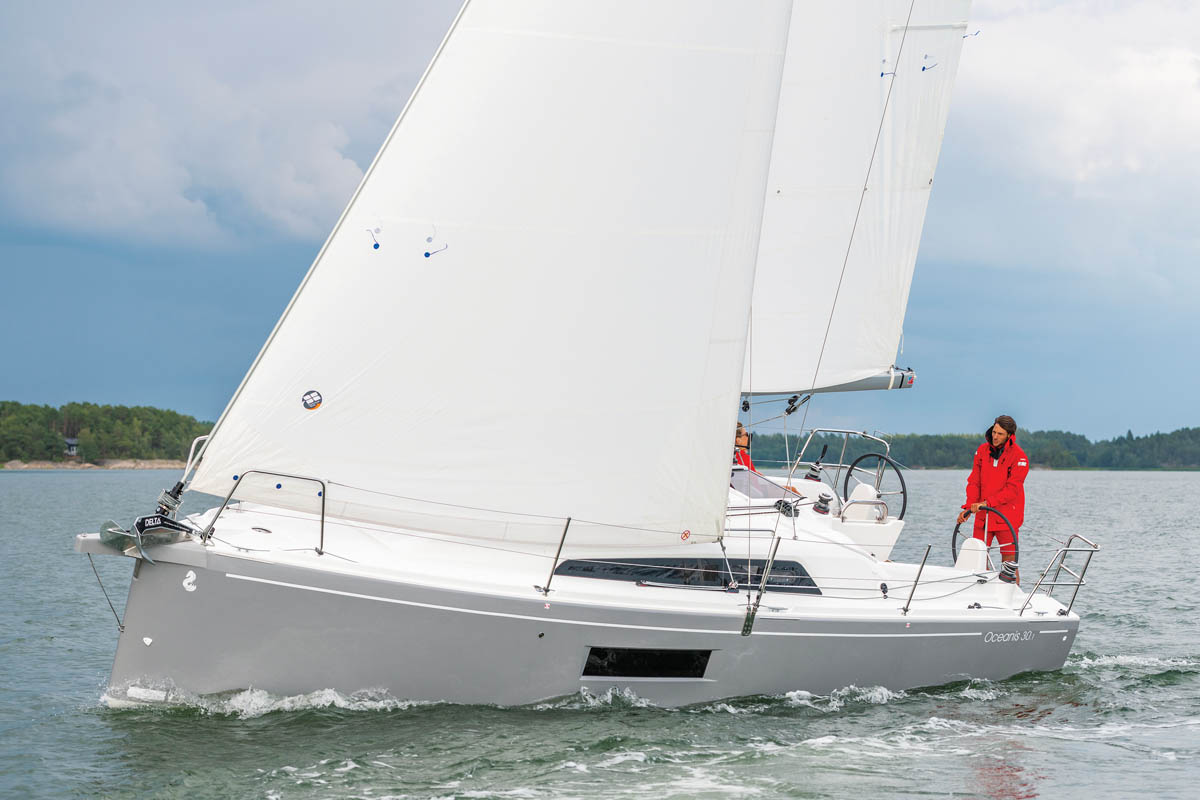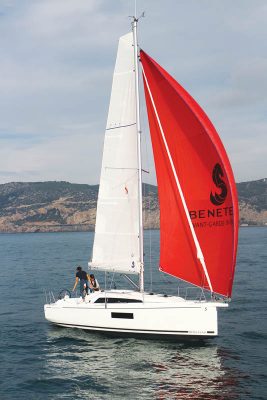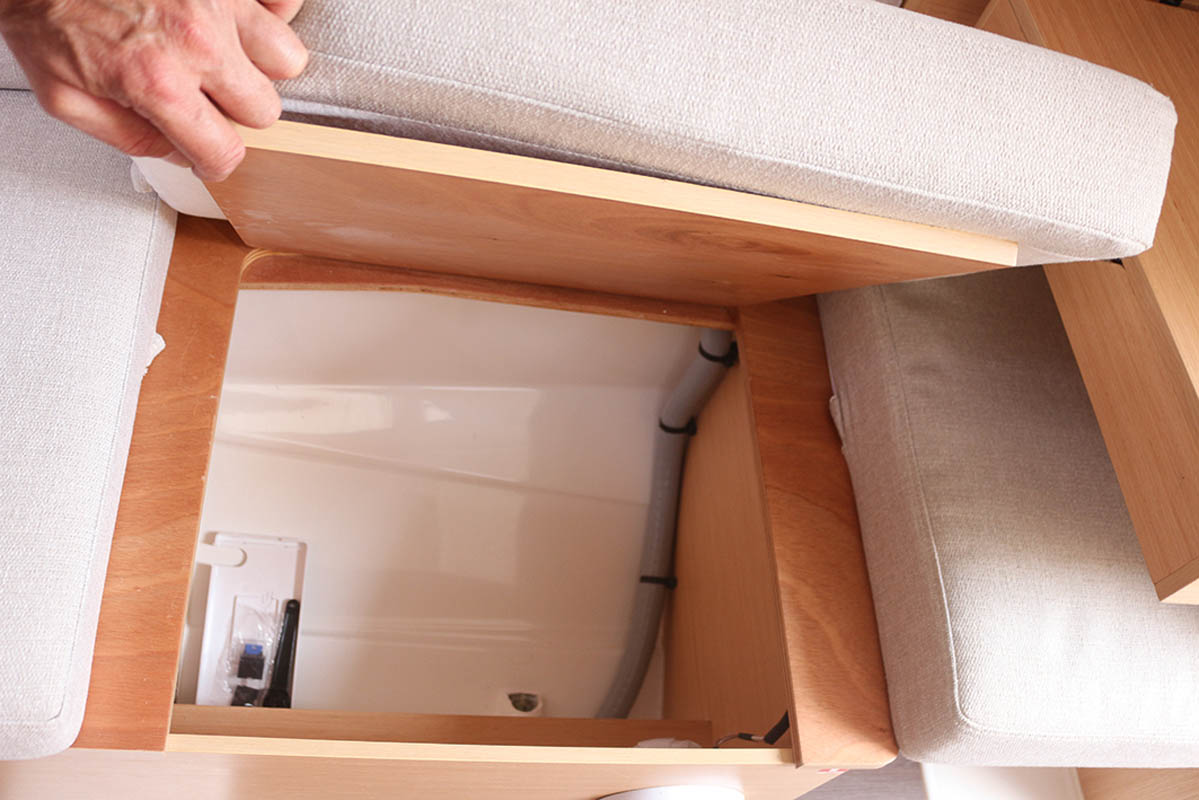The new Beneteau Oceanis 30.1 is a spacious and well mannered addition to the range. Rupert Holmes reports
Thirty years ago a small boat might have been anything less than around 24ft. However, that number has since leapt upwards, with many large manufacturers paying scant attention in the last ten years to building anything under 35ft.
Part of the argument for this is that smaller boats are less economic to build at a price the market will bear. Almost as much labour goes into building a 28-footer as a 35-footer and both have the same number of engines, instruments, masts and deck fittings that must be installed.
So it’s welcome news that Beneteau has clearly put a lot of thought, effort and knowledge into its latest model. As a result the Oceanis 30.1 sets new standards for a boat that’s just short of 30ft.
Although the overall dimensions are modest, high freeboard is combined with maximum beam carried well aft to create impressive internal volume. At the same time advances in yacht design, allied with a powerful deep draught bulb keel, make this a fast and well mannered 30-footer by any standards.
The new boat is a twin rudder design with somewhat smaller overall dimensions than the Oceanis 31, which was launched way back in 2006. The relatively narrow beam of less than 3m means the boat can be delivered by road without needing an escort. That saves a useful chunk of money that can be passed on to buyers.
Built at the former Delphia factory in Poland (Beneteau bought the company in 2018) the options list has been streamlined to pare back the price – keeping the production process simple also helps keep the base price down, without compromising quality.
Nevertheless there are three different keel options. Standard is a cast iron 1.88m (6ft 2in) bulb, while a shoal draught option reduces draught to just 1.3m (4ft 3in), but adds 177kg (390lb) of ballast to help maintain stability. There’s also a lifting keel with draught of 0.95 to 2.33m (3ft 1in to 7ft 8in) and a further 150kg (330lb) of ballast.
On deck
The broad transom gives space for a very large cockpit – we had five people on board without feeling as though there was any lack of space.
Our test boat had the optional twin wheels, rather than the large central wheel of the older Oceanis 31 that was hard to move around and divided up the space.
However, my preference would be for the standard single tiller, which is connected to the rudders by a below-deck tie bar. This gives an extra seven inches length to the cockpit seats, as well as avoiding unnecessary extra weight, complexity and expense.
Although it’s an open transom design, the cockpit floor is a reasonable distance above the waterline and there’s a fold-down bathing platform that would also facilitate boarding from a dinghy.
The central folding cockpit table is supported by a substantial stainless steel hoop, so you don’t feel vulnerable in the wide cockpit when the boat is well heeled and there’s always somewhere solid to brace your feet. Access to the top of each rudder stock is on the cockpit floor, which makes them easy to reach in an emergency.
An optional bowsprit makes sense for setting spinnakers and reaching sails and for its integrated anchor stowage. There’s also a deep chain locker with space for an electric windlass.
There’s a gas locker at the aft end of the cockpit for a single camping gaz bottle and next to it a hot and cold water deck shower. The deep and cavernous locker on the starboard side of the cockpit has a narrow, but long, opening with the lid supported by gas struts. However, there’s no dedicated liferaft stowage.
To accommodate the square top main sail the fractional rig has no backstay. Instead, the spreaders are very well swept aft. There’s much to recommend the simplicity of this arrangement, but the lack of a backstay means that, unlike most fractional rigs, the mainsail cannot be depowered as easily, and on our test boat there was a lot of forestay sag when sailing upwind.
Under sail
The shape of the Finot Conq-designed hull follows that of recent successful short-handed offshore raceboats, including a long waterline, full length chine and relatively broad forward sections. However the latter are more conservative than Beneteau’s larger Oceanis 46.1 and 51.1 models, or racing oriented designs such as Jeanneau’s Sun Fast 3300.
Our test boat was equipped with the standard Dacron mainsail with a square top and two reefs, plus the optional bowsprit and asymmetric spinnaker kit. A 105% slightly overlapping headsail is also offered in place of the standard self tacking jib and adds a useful 6.4sq m (69sq ft) of extra area.
This sail plan is sufficiently large to give good light weather performance – on the second day of the test the boat still made respectable progress reaching under spinnaker in winds below five knots.
Primary winches are mounted at the back of the cockpit coaming, just forward of the helm stations. They can therefore be reached while steering, while a single crew member can handle the sheets in a tack without the table getting in the way.
Initially, we set off close hauled with full sail in 12 to 13 knots of true wind. The boat felt solid and comfortable, while making a decent speed of 5.6 to 5.8 knots. Compared to older boats of this size it’s amazingly stable, thanks to a combination of the high level of form stability and the deep bulb keel. On the basis of experience during the test, the boat is likely to stand up to full sail when close-hauled up to true wind speed of around 15 knots (around 19 knots apparent).
In common with other twin-rudder boats, the helm felt positive and light at all times, even when we pressed hard under the asymmetric spinnaker later in the test.
Despite the narrow side decks, moving around is straightforward and when well-heeled it’s easy to step onto the coachroof to get past the windward shrouds. In less idyllic conditions, when you want to keep weight low, the coachroof has good stainless steel handrails at a convenient height.
The mainsail is sheeted to a bridle over the companionway and taken to a relatively small Harken 20 coachroof winch. This means it can’t be handled from the helm, which is clearly a disadvantage. In addition, the blocks for the tackle were a little far aft, so they would not automatically clear the head of anyone standing in the companionway.
Rope bags were provided on our test boat although, as is often the case, they would benefit from being larger. The towed genoa cars enable the headsail to continue to be trimmed to an efficient shape even when well reefed in stronger winds.
Turning back towards base, we hoisted the asymmetric kite. With the true wind increasing slightly to 14-15 knots, the boat remained well balanced and finger light on the helm, even when we luffed to bring the apparent wind on the beam, with the boat fully powered up.
Boat speed at this stage was consistently 7 to 7.5 knots, yet we were sailing in full cruising mode with no one tending the sheets. This puts the Oceanis 30.1 in a different class to older designs in which rudder loads can rise alarmingly if sheets aren’t eased in gusts.
Under power
The engine installation is very neat, with main access from the front, behind companionway steps that lift on gas struts. There are also access panels at the back and on both sides.
The standard 15hp diesel inboard is recommended only for inland waters and our test boat was fitted with a 21hp model allied to a fixed two blade propeller that proved more than adequate in size. At 3,000rpm boat speed is seven knots in flat water, while 6.4 knots is achieved at a more comfortable 2,400rpm.
There’s no escaping that twin rudder boats handle differently under power. However, most are entirely predictable in this respect and have reassuring control in reverse. Therefore, what you lose in not having prop wash over the rudder to make tight turns is gained in other ways. The 30.1 performed exactly as expected, including quickly gaining steerage in reverse, even when head to wind.
Below decks
Easy companionway steps lead to a bright and spacious saloon that belies the boat’s dimensions. Natural light and ventilation pour through hull windows, overhead hatches, coachroof windows and opening ports, while headroom of well over 1.8m (6ft) adds to the feeling of space.
A large folding central table in the saloon has stowage both in the top and underneath. Most of the saloon’s stowage is under the settees, but unlike most boats where this is difficult to reach, the 30.1 has split cushions and large hinged plywood locker tops which gives easy access.
Impressively there’s space for a small navigation table that can be deployed in a number of different modes, including folded up against the bulkhead or hinged down above the aft end of the port settee. Alternatively, the aft section of the settee can be removed, allowing someone to sit at the chart table in a conventional way.
The heads compartment is a very impressive size for a small boat and is built so you can brace yourself in a seaway. On the other hand the galley is relatively compact, with the lid of the generous 75lt insulated coolbox doubling as the only worktop space and there’s only a single sink.
Nevertheless, an opening port above the cooker, gains full marks for providing ventilation in warm weather and for letting out condensation on a rainy day.
Without question the forecabin is the best of the two, with a large bunk that has plenty of space, even at its foot. The double doors to this cabin accentuate the general feeling of space on board, creating a semi open-plan layout. However, with the doors closed there’s ample shoulder room to stand and change clothes.
Good stowage is also provided in this area, including a shelved cupboard on the starboard side and a hanging locker to port.
The aft cabin is smaller and the inner half of the berth does not give space to sit up in bed, although the berth dimensions are again generous. There is space in both cabins to put the small items like phones, keys and wallets that so often create disorganised clutter.
PBO verdict
Most developments in new yachts are small evolutions, but the 30.1 represents a step change for a vessel of its size. This reflects a huge amount of development in yacht design over the past decade or so, which has coincided with a period in which the big boatbuilders have largely ignored boats of this size.
The interior does not feel like that of a boat with a beam of less than 3m, nor one that has a hull length of only 29ft 6in – it’s more akin to the accommodation of many 32-34ft models from 25 years ago. Equally, the speed potential and therefore passage times of this boat, with its long waterline length, will not be dissimilar to many larger older boats.
However, the biggest difference between this boat and older designs of a similar size is in handling under sail. The combination of a high stability hull form, efficient sail plan, deep low centre of gravity keel and twin rudders provide a totally different experience, especially in gusty conditions.
This boat is often referred to as a starter boat, but that’s a description that perplexes me. Granted, it would be a great first boat, but equally there are many old hands who don’t need or want a boat of more than 30ft, but would value a new model that incorporates the latest advances in yacht design.
Beneteau Oceanis 30.1: specifications
- Hull length 8.99m (29ft 6in)
- LWL 8.65m (28ft 5in)
- Beam 2.99m (9ft 10in)
- Draught (standard keel) 1.88m (6ft 2in)
- Displacement 3,995kg (8,809lb)
- Ballast (standard keel) 973kg (2,144lb)
- Sail area 34.5m2 (370ft2)
- RCD category B (6 people)
- Base price ex VAT £67,200
- Typical on the water price ex VAT £89,500
- www.beneteau.com
Originally published in PBO Mar 2020













